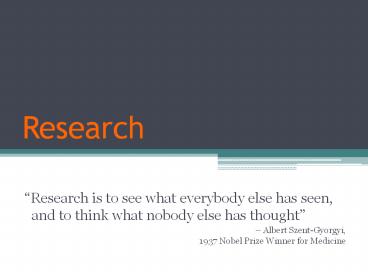Research PowerPoint PPT Presentation
1 / 15
Title: Research
1
Research
- Research is to see what everybody else has seen,
and to think what nobody else has thought - Albert Szent-Gyorgyi,1937 Nobel Prize Winner
for Medicine
2
Intellectual exploration.
Research goes into worlds of knowledge beyond
personal experience to probe an issue or solve a
problem, but research requires a plan and
organization.
3
Research Plan
- Develop a Topic or Focus
- Locate Sources (Two Types of Sources)
- Evaluate Sources for Validity
- Assess Sources for Usefulness
- Notes Quotes, Summaries Paraphrasing
- Citing Source to Avoid Plagiarism
- Research is formalized curiosity. It is poking
and prying with a purpose. - Zora Neale Hurston
4
Develop a Topic or Focus
- Start with your curiosity, and brainstorm broad
ideas. Think about what you already know and what
you want to know. - Conduct a preliminary reading of general research
to discover what sources pertinent to your
topic are accessible. - Refine general topics to a specific questionthat
you can fully explore within the scope of your
project.
5
Know Your Sources
A world of information is only a mouse-click
away, but understanding and evaluating sources
will help you find the most reliable and useful
research to support your topic and satisfy your
curiosity.
Somewhere, something incredible is waiting to be
known. Dr. Carl Sagan
6
Primary and Secondary Sources
A primary source is the work itself, such as The
Cask of Amontillado, Martin Luther Kings I
Have a Dream speech, A Separate Peace, or Romeo
and Juliet. Primary sources can also include
journalism, letters and diaries. A secondary
source is a work written about a primary source.
Examples include critical commentaries such as
Catherine Belseys essay The Name of the Rose in
Romeo and Juliet or critical essays in
Contemporary Literary Criticism.
7
Classifying Sources
Consider this model of sources when selecting the
types of research that will most effectively lend
authority to your project.
General Encyclopedias
General-interest Magazines and Newspapers
Specialized Magazines
Trade Books
Government Documents
AcademicJournals
ScholarlyBooks
More Specialized KnowledgeMore Authoritative
8
Evaluating Sources
- Ask the following questions to help you determine
the reliability of your sources - What are the authors credentials?
- In which journal or book is the essay published?
(Academic journals required for literary
criticism. For historical or social context,
popular magazines and newspapers are acceptable,
but use a critical eye to evaluate the reputation
of the magazine for bias and reliability.) - Does the article quote the text and subject you
are researching and provide documentation? - Does the article include a bibliography at the
end? (Hint you can use a bibliography to locate
additional resources on your topic.)
9
Evaluating Sources
Lets take a test run See if you can pick out
the good from the bad and the ugly
There is nothing like looking, if you want to
find something. You certainly usually find
something, if you look, but it is not always
quite the something you were after. J.R.R.
Tolkien
10
Assessing Sources
- Before you commit to a source, go on a date!
- Skim the intro and conclusion to consider the
authors tone, point of view and what types of
evidence he or she includes to support the
thesis. - And take a look at the references the
essayists research could lead you to a more
useful source!
11
Collecting Information
- Cite the source and bibliographic info in MLA as
soon as you access the essay. If you dont,
Murphys Law says that later you will need that
source and wont be able to locate it. - Read the essay and copy down important passages
word for word with all page references and
punctuation. This is critical for documenting
your sources and avoiding plagiarism (which
results in an automatic zero).
12
Quoting, Paraphrasing, Summarizing
- Quotations must be identical to the original,
using a narrow segment of the source. They must
match the source document word for word and must
be attributed to the original author. - Paraphrasing puts a passage from source material
into your own words and must also be attributed
to the original source. Paraphrased material is
usually shorter than the original passage, taking
a somewhat broader segment of the source and
condensing it slightly. - Summarizing involves putting the main ideas into
your own words, including only the main points.
Once again, it is necessary to attribute
summarized ideas to the original source.
Summaries are significantly shorter than the
original and take a broad overview of the source
material.
13
Quoting, Paraphrasing, Summarizing
- Quotations, paraphrases, and summaries serve many
purposes. You might use them to . . . - Provide support for claims or add credibility
to your writing - Refer to work that leads up to the work you are
now doing - Give examples of several points of view on a
subject - Call attention to a position from which you
agree or disagree - Highlight a particularly striking phrase,
sentence, or passage by quoting the original - Distance yourself from the original by quoting
it in order to cue readers that the words are not
your own - Expand the breadth or depth of your writing
14
How to Quote, Paraphrase, Summarize
- Read the entire text, noting the key points and
main ideas. - Summarize in your own words the single main idea.
- Paraphrase important supporting points.
- Consider any words, phrases, or brief passages
that you believe should be quoted directly.
15
FAQ Research
For this research project, you will look more
fully into the social, historical and political
circumstances during the genocide from your
nonfiction novel group. Start with some general
research on the six required questions. Then
refine and narrow your focus on further questions
that draw your interest or curiosity.

